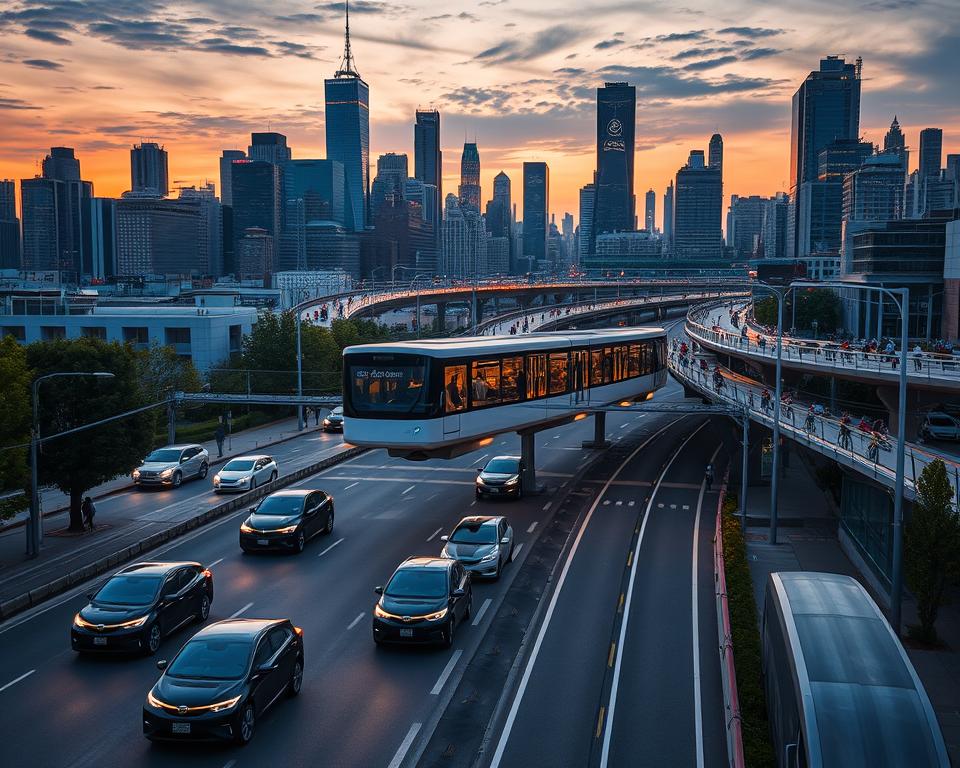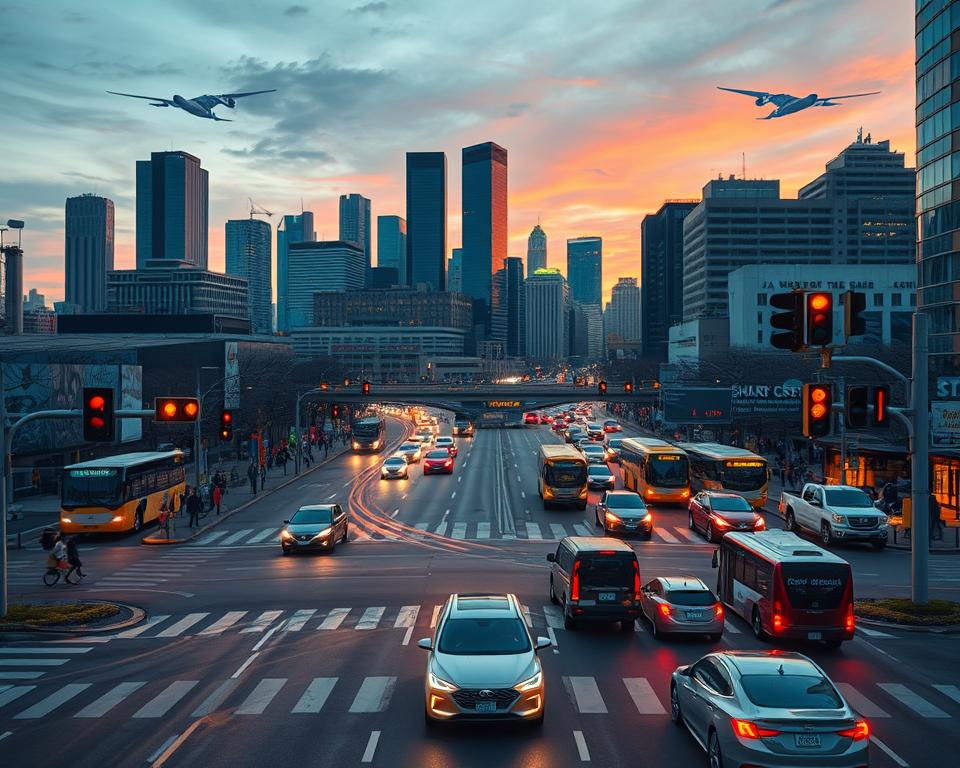Creating a smart traffic system is key to better city travel and less traffic jams. By using smart apps for traffic and public transport, cities can make travel faster, cleaner, and better for everyone. This is done by using real-time data and smart algorithms to manage traffic and public transport.
To make smart traffic and public transport apps work well, you need to understand how traffic, public transport, and city planning work together. A smart app can make travel in cities more efficient, green, and good for commuters. This guide will show you how to make such an app, covering the basics of smart traffic and public transport apps.
Table of Contents
Key Takeaways
- Smart traffic management systems can reduce congestion and improve air quality in urban areas.
- Public transport app development is critical for enhancing the commuter experience and optimizing public transportation systems.
- Real-time data and intelligent algorithms are essential for optimizing traffic flow and public transportation systems.
- Effective smart traffic management and public transport app development require a deep understanding of urban infrastructure and transportation systems.
- Developing a comprehensive smart traffic and public transport management app can create a more efficient, sustainable, and commuter-friendly transportation system.
Understanding the Smart Transportation Ecosystem
The current state of urban transportation faces big problems like congestion, pollution, and inefficiencies. It’s crucial to find and use urban mobility solutions to solve these issues. These solutions can make traffic flow better, cut down pollution, and offer more reliable travel options.
One important part of these solutions is traffic monitoring systems. They help city planners and officials keep an eye on traffic in real-time. This way, they can manage traffic more effectively.
Some major challenges in urban transportation include:
- Congestion and traffic jams
- Pollution and environmental degradation
- Inefficient public transportation systems
Smart transportation solutions can tackle these problems. For example, intelligent traffic signals, public transportation tracking, and ride-sharing platforms can help. By using these, cities can lessen congestion, pollution, and offer better travel options.
Market research shows a growing need for smart transportation solutions. This need comes from a desire for more efficient and green travel choices. Key players in this ecosystem are government agencies, private companies, and commuters. Together, they can shape the future of urban transport. By collaborating, they can create urban mobility solutions that meet commuter needs while reducing traffic and pollution.
Essential Features for Traffic Management Integration
Intelligent transportation systems are changing how cities handle traffic. They use technology to cut down on traffic jams, make travel faster, and clean the air. Key features include real-time traffic watching, predicting traffic patterns, and controlling traffic lights.
These tools can be added to a smart app for traffic and public transport. This app gives people the latest info to plan their trips. For instance, real-time traffic monitoring helps people steer clear of busy spots. Meanwhile, predictive analytics helps cities spot and solve traffic problems before they start.
Some cities have already made these integrations work well. Here are a few examples:
- Real-time traffic updates
- Dynamic traffic signal control
- Predictive analytics for traffic forecasting
By adding these features, cities can make their transport systems better. They become more efficient, green, and friendly to citizens. This shows how smart transport systems and technology can change city travel for the better.
Technical Requirements and Architecture Planning
Creating a smart traffic and public transport app needs a strong technical base. This includes looking at backend setup, database design, and API connections. These ensure the app works well, is safe, and can grow. A good app can make cities better and more green.
Choosing the right backend is key in mobile app development. You need to pick a programming language, framework, and database system. For example, a cloud-based setup can make the app flexible and scalable. It can handle lots of users and data.
- Backend infrastructure setup: This involves setting up servers, databases, and APIs to support the app’s functionality.
- Database design: A well-designed database is critical for storing and retrieving data efficiently, ensuring the app’s performance and scalability.
- API integration: Integrating APIs from various sources, such as traffic data providers or payment gateways, can enhance the app’s functionality and user experience.
By planning the app’s technical needs well, developers can make a strong and useful system. This system meets user and stakeholder needs. It helps with better urban planning and managing transport.
Real-time Data Collection and Processing Systems
Real-time data collection is key for good traffic monitoring systems. By using data analytics, cities can make traffic flow better, predict jams, and enhance travel for everyone. Real-time data lets traffic managers act fast on problems, cutting down on traffic and saving time.
Systems like traffic cameras, sensors, and social media feeds collect real-time data. They give cities insights into traffic, helping them make smart choices. For example, traffic systems can adjust lights in real-time to cut down on traffic and pollution.
Here are some benefits of real-time data collection and processing systems:
- Improved traffic flow and reduced congestion
- Enhanced commuter experience and reduced travel times
- Data-driven decision making for traffic management
- Increased safety and reduced incident response times
Investing in real-time data systems makes cities smarter and more efficient. This leads to better traffic, less congestion, and a better ride for everyone. As cities grow, the need for real-time data will keep rising, making it vital for traffic systems.
How to Develop a Smart Traffic & Public Transport Management App: Core Components
Creating a top-notch public transport app needs careful thought about key parts. These parts work together to make moving around easy for users. When making a public transport app, it’s key to add features that meet different commuter needs.
A good app should have traffic monitoring, public transport tracking, and emergency response systems. These help users plan trips, get updates in real-time, and get help in emergencies. By adding these, developers can make an app that’s easy to use and dependable.
Some important features of a smart traffic and public transport app include:
- Traffic monitoring and updates
- Real-time public transport tracking
- Emergency response integration
- Route planning and optimization
These features help make a complete mobility solution. They improve the user experience and encourage using public transport.
By focusing on these core parts, app developers can make an app that meets user needs. It also helps make transportation more efficient and green. Adding emergency response systems and public transport app development is crucial for the app’s success.
User Interface Design for Multiple Stakeholders
Creating a smart traffic and public transport app needs to think about many people. This includes commuters, transport operators, and city planners. A good user experience design is key to making the app popular and useful. By focusing on user experience, developers can make an app that is easy to use and meets many needs.
It’s important to give users clear and concise information so they can choose the best transport option. Using real-time data and interactive maps helps users find their way. Also, adding mobility solutions like better routes and traffic forecasts makes the app better.
Some key ideas for user-centered design in app development are:
- Understanding what different users need and how they behave
- Testing prototypes with users to improve the design
- Making the app’s interface simple and consistent
By following these ideas and focusing on user experience, developers can make a smart app. This app will be helpful and easy to use, improving mobility solutions for everyone.
Implementation of AI and Machine Learning Algorithms
AI and machine learning are changing how we manage traffic and public transport. They help cities make their transport systems better. For example, smart traffic systems use real-time data to ease traffic jams.
AI and machine learning have many uses in transport:
- They help predict traffic jams, so cities can get ready.
- Route optimization systems cut down travel times and emissions.
- They spot incidents quickly, helping respond fast.
AI and machine learning make transport systems better, safer, and greener. Machine learning algorithms analyze lots of data to find patterns. This helps cities make smarter choices. As AI in transport grows, we’ll see new ways to travel and interact with cities.
Security and Data Privacy Protocols
Keeping user data safe is key for a smart traffic app. It must protect against unauthorized access and keep the system sound. By using privacy protocols, developers can keep user info private.
Good practices for data security include encrypting sensitive data and using strong login methods. Also, updating software often helps avoid security holes. Using privacy protocols like data anonymization and secure storage can also stop data leaks.
- Do regular security checks to find weak spots
- Have plans ready for data breaches
- Let users know how their data is used
By focusing on data security and privacy protocols, developers can earn user trust. This makes the app safe and reliable for everyone.
Integration with Existing City Infrastructure
For smart cities to thrive, linking with current infrastructure is key. This connection boosts the efficiency of traffic management systems. For example, working with traffic signals lets cities watch and adjust traffic in real-time. This cuts down on jams and shortens travel times.
Smart traffic systems play a big role here. You can learn more about them in the article smart traffic management systems.
Urban infrastructure integration brings many benefits:
- It makes traffic flow better and reduces congestion.
- It boosts public safety by coordinating emergency services.
- It makes cities more efficient and saves money.
Look at cities that have smart systems for a good example. They’ve seen big improvements in traffic and safety. These cities are great examples for others to follow. You can find more about this in articles on developing taxi apps or mobile sites.
By using smart city solutions and infrastructure integration, cities can become better places to live. This is done by planning and setting up systems that meet each city’s needs. It’s all about making cities more efficient, green, and welcoming for everyone.
Mobile App Development Strategy
Creating a smart traffic and public transport app needs a solid mobile app development strategy. It’s about knowing what users want, making the app easy to use, and linking it well with current systems. A top urban mobility app should give live updates, help plan routes, and be easy for users.
To get it right, follow the best mobile app development practices. This means doing deep market research, making a clear design plan, and testing the app a lot. A good mobile app development strategy also means keeping the app updated and adding new features based on user feedback and trends in urban mobility apps.
Some important things to think about in a mobile app development strategy are:
- Figuring out the app’s purpose and who it’s for
- Creating an interface that’s easy and fun to use
- Making sure it works well with what’s already there
- Offering updates in real-time
- Helping users plan their routes efficiently
By sticking to a well-thought-out mobile app development strategy, developers can make urban mobility apps that really help users. These apps can make traffic better and improve how we move around cities.
Testing and Quality Assurance Protocols
It’s key to make sure a smart traffic app works well. That’s why software testing and quality assurance are so important. By testing a lot, developers can find and fix problems. This makes the app better and meets what users want. For example, learning from successful app development helps in testing.
helps check how the app does under different situations. It looks at how it handles lots of users, data, and real-time info. This makes sure the app is reliable and easy to use.
Performance Testing Methods
- Load testing to see how the app does with lots of users
- Stress testing to check how it handles extreme situations
- Endurance testing to see how it performs over time
Security Testing Procedures
Developers must test the app’s security well. This includes things like penetration testing and checking for vulnerabilities. It helps find and fix security issues. By visiting smart traffic management systems, you can see why security is so important.
Deployment and Maintenance Planning
Getting a smart traffic and public transport app up and running is key. This means setting up servers, configuring databases, and making sure users can easily start using the app. It’s important to test everything, have backup plans, and have a support system ready.
After the app is live, keeping it running smoothly is crucial. This includes watching how the app performs, fixing any problems, and updating it regularly. A good plan for upkeep helps avoid downtime, keeps data safe, and makes the app better for users.
Some important things to think about for app deployment and maintenance planning are:
- Setting up servers and configuring them
- Designing and managing databases
- Using security measures and encrypting data
- Helping users get started and offering support
- Keeping an eye on how the app performs and using data to improve it
By focusing on maintenance planning and following best practices for app deployment, developers can make sure their app is reliable, efficient, and safe. This gives users a great experience.
Monetization Strategies and Business Models
Creating a smart traffic and public transport app needs careful thought on app monetization and business models. A good plan balances making money with keeping users happy and making a positive impact. Successful apps use ads, premium features, and data services to make money.
Apps can also partner with local businesses, transport agencies, and governments. For example, they can offer exclusive discounts to users who visit certain places. This helps local businesses grow. By using these strategies, developers can make a business model that works for everyone.
To grow the business, it’s important to keep users engaged and happy. Developers should always be looking to improve the app. This way, they can keep users coming back and make more money through app monetization.
Some key things to think about when growing the business include:
- Getting more users through targeted ads
- Adding new features to meet user needs
- Forming partnerships to boost revenue and user experience
By being flexible and adaptable with business models and app monetization, developers can make a successful app. It will benefit users and the environment.
Conclusion
Developing a smart traffic and public transport system is key for solving urban mobility issues. Cities can use real-time data, predictive analytics, and smart algorithms. This helps make travel faster, safer, and more efficient.
It’s important to take a complete view of the problem. This includes the needs of everyone involved, from city planners to citizens. Technology can help cities change their infrastructure and improve how they handle emergencies.
Starting a smart transportation project might seem hard, but the benefits are huge. With smart traffic and public transport apps, cities can make travel smoother. This leads to a better environment and a higher quality of life for everyone.



















